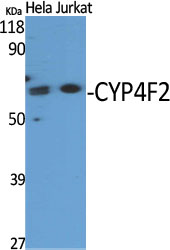CYP4F2 Polyclonal Antibody
- SPECIFICATION
- CITATIONS: 1
- PROTOCOLS
- BACKGROUND

Application
| WB, IHC-P |
|---|---|
| Primary Accession | P78329 |
| Reactivity | Human |
| Host | Rabbit |
| Clonality | Polyclonal |
| Calculated MW | 59853 Da |
| Gene ID | 8529 |
|---|---|
| Other Names | CYP4F2; Leukotriene-B(4) omega-hydroxylase 1; CYPIVF2; Cytochrome P450 4F2; Cytochrome P450-LTB-omega; Leukotriene-B(4) 20-monooxygenase 1 |
| Dilution | WB~~Western Blot: 1/500 - 1/2000. Immunohistochemistry: 1/100 - 1/300. ELISA: 1/40000. Not yet tested in other applications. IHC-P~~N/A |
| Format | Liquid in PBS containing 50% glycerol, 0.5% BSA and 0.09% (W/V) sodium azide. |
| Storage Conditions | -20℃ |
| Name | CYP4F2 {ECO:0000303|PubMed:10492403, ECO:0000312|HGNC:HGNC:2645} |
|---|---|
| Function | A cytochrome P450 monooxygenase involved in the metabolism of various endogenous substrates, including fatty acids, eicosanoids and vitamins (PubMed:10660572, PubMed:10833273, PubMed:11997390, PubMed:17341693, PubMed:18574070, PubMed:18577768). Mechanistically, uses molecular oxygen inserting one oxygen atom into a substrate, and reducing the second into a water molecule, with two electrons provided by NADPH via cytochrome P450 reductase (CPR; NADPH-ferrihemoprotein reductase). Catalyzes predominantly the oxidation of the terminal carbon (omega-oxidation) of long- and very long-chain fatty acids. Displays high omega-hydroxylase activity toward polyunsaturated fatty acids (PUFAs) (PubMed:18577768). Participates in the conversion of arachidonic acid to omega-hydroxyeicosatetraenoic acid (20-HETE), a signaling molecule acting both as vasoconstrictive and natriuretic with overall effect on arterial blood pressure (PubMed:10660572, PubMed:17341693, PubMed:18574070). Plays a role in the oxidative inactivation of eicosanoids, including both pro-inflammatory and anti- inflammatory mediators such as leukotriene B4 (LTB4), lipoxin A4 (LXA4), and several HETEs (PubMed:10660572, PubMed:10833273, PubMed:17341693, PubMed:18574070, PubMed:18577768, PubMed:8026587, PubMed:9799565). Catalyzes omega-hydroxylation of 3-hydroxy fatty acids (PubMed:18065749). Converts monoepoxides of linoleic acid leukotoxin and isoleukotoxin to omega-hydroxylated metabolites (PubMed:15145985). Contributes to the degradation of very long-chain fatty acids (VLCFAs) by catalyzing successive omega-oxidations and chain shortening (PubMed:16547005, PubMed:18182499). Plays an important role in vitamin metabolism by chain shortening. Catalyzes omega-hydroxylation of the phytyl chain of tocopherols (forms of vitamin E), with preference for gamma-tocopherols over alpha-tocopherols, thus promoting retention of alpha-tocopherols in tissues (PubMed:11997390). Omega-hydroxylates and inactivates phylloquinone (vitamin K1), and menaquinone-4 (MK-4, a form of vitamin K2), both acting as cofactors in blood coagulation (PubMed:19297519, PubMed:24138531). |
| Cellular Location | Microsome membrane; Peripheral membrane protein. Endoplasmic reticulum membrane; Peripheral membrane protein |
| Tissue Location | Liver. Also present in kidney: specifically expressed in the S2 and S3 segments of proximal tubules in cortex and outer medulla (PubMed:10660572). |

Provided below are standard protocols that you may find useful for product applications.
Background
Omega-hydroxylase that oxidizes a variety of structurally unrelated compounds, including steroids, fatty acids and xenobiotics. Plays a key role in vitamin K catabolism by mediating omega-hydroxylation of vitamin K1 (phylloquinone), and menaquinone-4 (MK-4), a form of vitamin K2. Hydroxylation of phylloquinone and MK-4 probably regulates blood coagulation (PubMed:19297519, PubMed:24138531). Also shows arachidonic acid omega-hydroxylase activity in kidney, by mediating conversion of arachidonic acid to 20-hydroxyeicosatetraenoic acid (20-HETE), possibly influencing blood pressure control (PubMed:10660572, PubMed:17341693, PubMed:18574070). Also acts as a leukotriene-B(4) omega-hydroxylase by mediating conversion of leukotriene-B(4) (LTB4) to its omega-hydroxylated metabolite 20-hydroxyleukotriene- B(4) (20-OH LTB4) (PubMed:8026587, PubMed:9799565).
If you have used an Abcepta product and would like to share how it has performed, please click on the "Submit Review" button and provide the requested information. Our staff will examine and post your review and contact you if needed.
If you have any additional inquiries please email technical services at tech@abcepta.com.














 Foundational characteristics of cancer include proliferation, angiogenesis, migration, evasion of apoptosis, and cellular immortality. Find key markers for these cellular processes and antibodies to detect them.
Foundational characteristics of cancer include proliferation, angiogenesis, migration, evasion of apoptosis, and cellular immortality. Find key markers for these cellular processes and antibodies to detect them. The SUMOplot™ Analysis Program predicts and scores sumoylation sites in your protein. SUMOylation is a post-translational modification involved in various cellular processes, such as nuclear-cytosolic transport, transcriptional regulation, apoptosis, protein stability, response to stress, and progression through the cell cycle.
The SUMOplot™ Analysis Program predicts and scores sumoylation sites in your protein. SUMOylation is a post-translational modification involved in various cellular processes, such as nuclear-cytosolic transport, transcriptional regulation, apoptosis, protein stability, response to stress, and progression through the cell cycle. The Autophagy Receptor Motif Plotter predicts and scores autophagy receptor binding sites in your protein. Identifying proteins connected to this pathway is critical to understanding the role of autophagy in physiological as well as pathological processes such as development, differentiation, neurodegenerative diseases, stress, infection, and cancer.
The Autophagy Receptor Motif Plotter predicts and scores autophagy receptor binding sites in your protein. Identifying proteins connected to this pathway is critical to understanding the role of autophagy in physiological as well as pathological processes such as development, differentiation, neurodegenerative diseases, stress, infection, and cancer.

.jpg)
